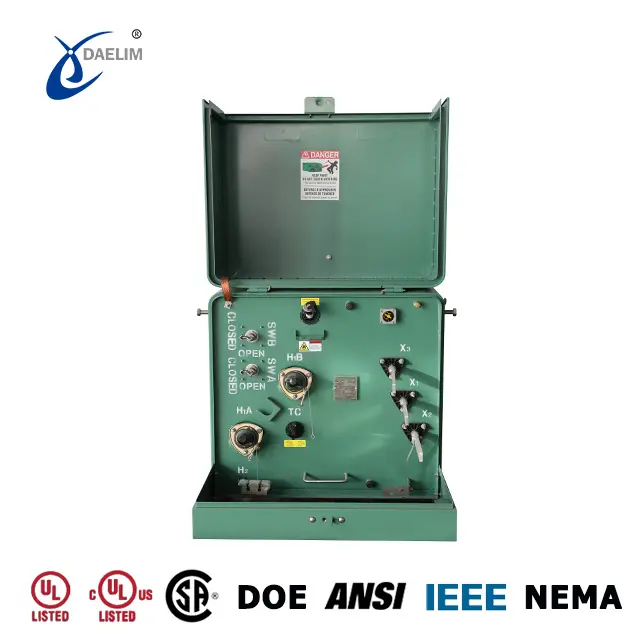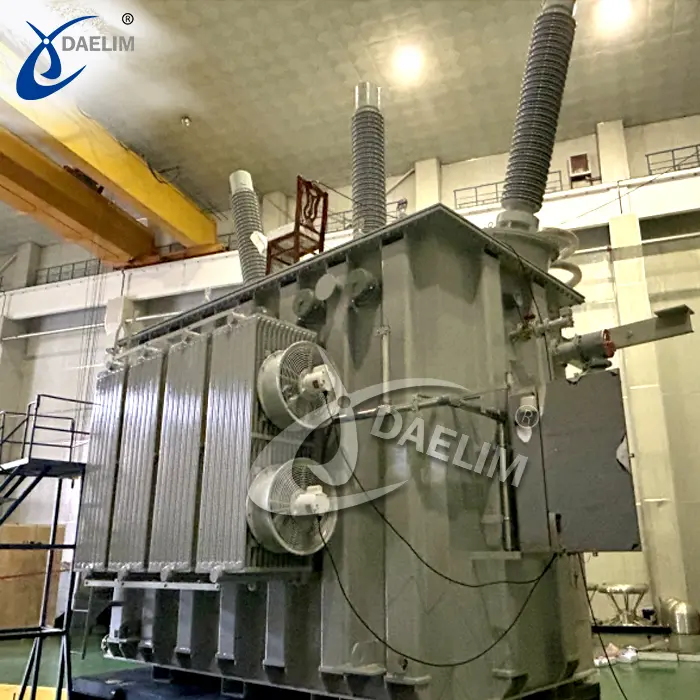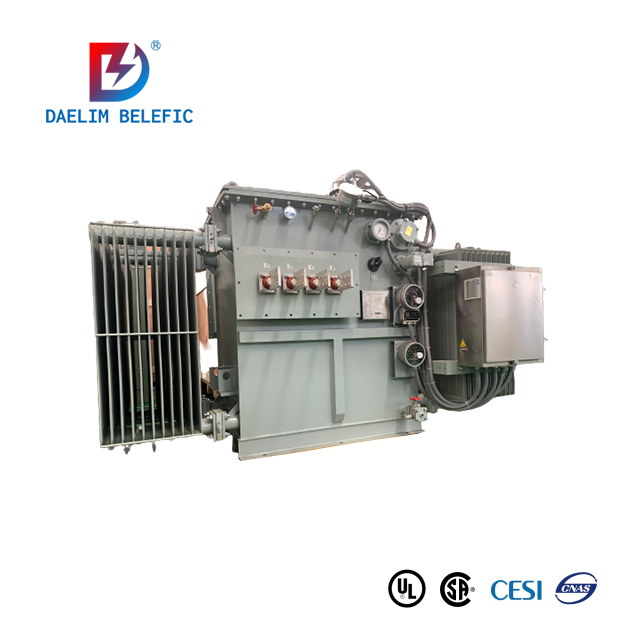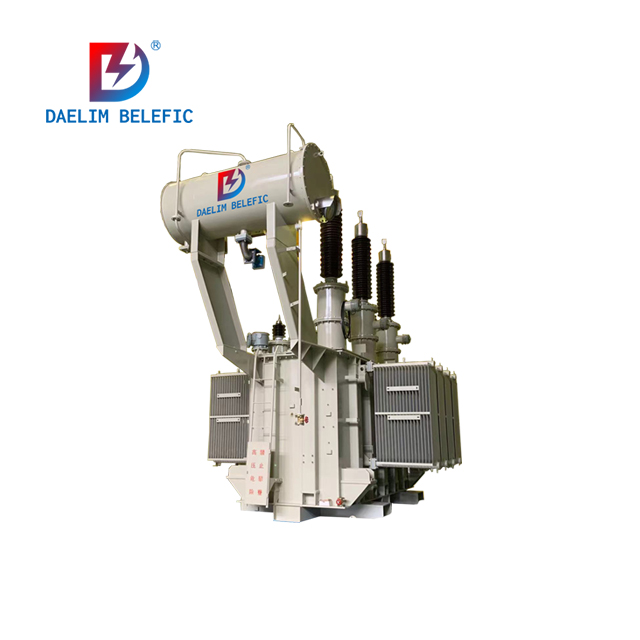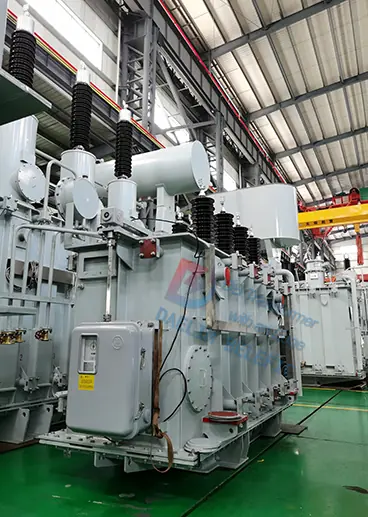12+ FAQ Guide on Transformer Ratings
How much transformer rating do you need? More than you think. If you're looking for a power transformer, you might be extremely surprised by how much capacity is available in the market today.
You'll find that most of them are practically rated to handle 10MVA, 20MVA, or even higher. But there are some transformers out there that can handle up to 100 MVA transformer ratings. These are all important considerations when choosing the right ones for your business.


Daelim is a transformer supplier that can provide a 10-270,000 kVA power rating. Transformers range from single-phase to three-phase, from oil to dry, from pole mounted to pad mounted, and from medium voltage to high voltage. Focusing on the North American market for nearly ten years, and proficient in ANSI/IEEE, CSA, NEMA, DOE, and other transformer standards. Therefore, if you have an inquiry, please Contact Daelim immediately.
In this section, we will discuss the operation of transformer ratings, as well as certain transformer rating charts and the significance of having them.
What Is Transformer Rating?
A power transformer rating is the maximum amount of electricity that it can safely and reliably transform. In most cases, this is always stated in kVA.
Read more: Ultimate Guide To Transformer Sizes and Ratings
How to choose the transformer power rating?
When choosing a transformer, it is important to take into account the power rating, which is generally established by the core size and winding layout. Next, we will mainly talk about the power rating selection of distribution and large power transformers.
Distribution Transformer

The capacity of the distribution transformer is usually relatively small, not exceeding 2500kVA, so the cooling methods are mainly ONAN and KNAN.
The power rating of the transformer is the highest amount of power it can withstand before the transformer's windings are irreversibly destroyed. According to Eddy current and hysteresis, copper losses and core losses, mean that no transformer can deliver its rated power.
The transformer winding can burn out or the insulation can break down if we deliver more power than the rated power.
Therefore, when choosing a distribution transformer power rating, it is best to be slightly higher than the total load of the equipment used. In this way, the transformer will run safer, more reliably, and have a longer life.
Related Article
What Is Distribution Transformer?
Large power transformer
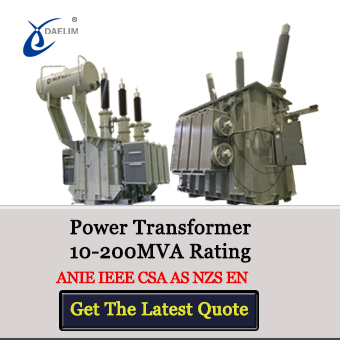 Large substation transformers typically have ratings for operation without cooling, with a single cooling stage, and with two cooling stages using forced air.
Large substation transformers typically have ratings for operation without cooling, with a single cooling stage, and with two cooling stages using forced air.
The oil in the transformer could be usually circulated with the help of a pump, leading to the possibility of a fourth rating that enhances heat transfer.
Natural oil circulation and air cooling (ONAN) receive the lowest possible ratings. The initial rating for forced air systems is oil natural air forced (ONAF). At this time, the transformer rating value will be higher. There are other cooling methods such as OFWF, ONWF, etc., by applying external force equipment to accelerate the cooling of the transformer, so that the transformer can reach a higher rating value during operation.
When you choose a large transformer, you can choose the corresponding cooling method according to your load requirements. Turn on the corresponding cooling mode under different loads to meet your needs for the transformer rating.
Reading more: Basic Guide To High Voltage Power Transformers
Transformer Rating Chart
| Single Phase Transformer | Pad Mounted Transformer | Small Substation Transformer | Power Transformer |
| 5kVA | 75kVA | 800kVA | 10MVA |
| 10kVA | 150kVA | 1000kVA | 12MVA |
| 15kVA | 300kVA | 1250kVA | 15MVA |
| 25kVA | 500kVA | 1600kVA | 20MVA |
| 37.5kVA | 750kVA | 2000kVA | 25MVA |
| 50kVA | 1000kVA | 2500kVA | 30MVA |
| 75kVA | 1500kVA | 3000kVA | 37.5MVA |
| 100kVA | 2000kVA | 5000kVA | 50MVA |
| 167kVA | 2500kVA | 7500kVA | 60MVA |
| 250kVA | 3000kVA | 10000kVA | 90MVA |
| 333kVA | 5000kVA | 15000kVA | 120MVA |
What is the ONAN ONAF transformer rating?
ONAN Transformer Rating
ONAN transformer rating refers to the capacity value of the transformer under the natural flow of air without any coercive measures for the oil in the transformer. That is the basic capacity of the transformer.
Learn more about ONAN Trangsormer
ONAF Transformer Rating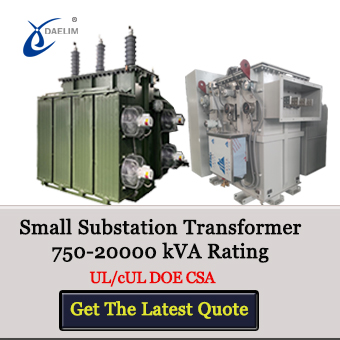
ONAF transformer rating refers to the transformer capacity value when the transformer accelerates heat dissipation by starting the fan. After the fan starts, the capacity of the power transformer increases by about 33.334% from the base capacity.
Alternatively, there is OFAF Transformer
OFAF Transformer means that the oil in the tank is forced to circulate through the oil pump. Compared with the ONAF cooling method, the transformer can be cooled faster during operation, so the capacity can be increased to about 66.33% of the basic capacity.
Daelim 44 kV 5/6.667MVA ONAN ONAF Power Transformer
In 2019, Daelim exported 3 sets of 44.4 kV/12.47 kV 5MVA power transformers to Canada, and the cooling method of the transformers is ONAN/ONAF. Applied CSA c88-M90 standard.
As can be seen from the nameplate in the figure below, the transformer is naturally cooled, and the basic capacity in the ONAN rating is 5MVA. When the fan is turned on, the capacity in the ONAF rating is 6.667MVA. These are the three sets of 44kV 5mva power that Daelim exported to Canada in 2019. At that time, the third-party organization SGS was asked to do the CSA C88 test and passed the test. It is currently running well in Quebec, Canada.
Why transformer rating is in kVA not in kW?

Try for free: Pad Mounted Transformer
The values from the transformer are commonly represented in kilovolt-amperes (kVA) because it does not have a fixed power factor.
Its power factor relies on the kind and nature of the resulting load.
kW=kVA×cos(phi).
cos(phi) = Power factor.
The power factor increases when a capacitive load is usually connected to the output, while the power factor decreases when an inductive load is also connected.
Ratings in kVA or MVA are generally applied for transformers for the following three primary purposes:
1. Both active and reactive power must be usually transferred from one AC circuit to another via the transformer.
It must thus transform total power, which is equal to apparent power
(S)=(P2 + Q2)(1/2).
Distribution transformer rating will be generally given in units of kVA or MVA since the "S" has a VA unit.
2. It is advantageous to grade a transformer in terms of total apparent power "S".
This is because it is unknown at the time of manufacture what kind of load it will support (e.g., R, RL, RC, RLC,) in kVA or MVA transformer rating.
3. Transformer losses are in two varieties:
- Copper loss, basically influenced by current
- Iron losses, which change with voltage
So, the total losses are equal to the iron losses + the copper losses, which depend on VA.
Related Article
Losses in Transformer: The Ultimate FAQs Guide - Daelim
How Do You Find The kVA Rating Of A Transformer?

We can usually find the kVA rating in transformer nameplates, drawings, outline drawings, and technical tables.
How to calculate the kVA rating of the transformer?
Of course, you can also calculate it before the transformer design.
The voltage and full load current may be usually multiplied to determine the kVA power rating of an electrical transformer.
The greatest apparent power the transformer can bear as a load is typically calculated by multiplying the maximum output current by the maximum output voltage.
First, convert the voltage to volts and the current to amps. Next, divide the result by 1000 to get the kilovolt-amperes (kVA) rating of the device.
FLC x Voltage (KV)
=√3* VL(KV) * FLC
Where,
Line Voltage = VL
For example:
To figure out how much current a 1kVA transformer can handle, you need to know either the voltage going in or coming out.
Let's say that the transformer is a perfect one that doesn't lose any power. (so the VA coming in and the VA going out are the same)
Say the voltage coming in is 11kV and the voltage coming out is 230V.
input current: S = U * I => I = S/U = 1000VA/11000V = 909mA
output current: S = U * I => I = S/U = 1000VA/230V = 4.348A
This is, of course, just a guess because transformers are never 100% efficient, but it can give a good idea.
Get it now: Three Phase Pad Mounted Transformer
What Is The Standard Ratings Of Transformers?
Theoretically, it's not hard to calculate how big a transformer is, and all sorts of different numbers may be easily figured out.
The standard power transformer ratings which frequently used in industrial and commercial buildings are: 
kVAs are amounting to 3, 6, 9, 15, 30, 37, 5, 45, 75, and 112.5.
As well as 150, 225, 300, 500, 750, and 1,000 kVA.
MVA Transformer Rating Standard for Single-Phase Transformers
There are typically 5kVA, 10kVA, 16kVA, 25kVA,37.5kVA,50kVA,100kVA and 167kVA ratings for single-phase transformers.
Distribution Transformer Rating Standard for 3-Phase Transformers
Distribution transformers for 11kV systems normally have 2500 kVA ratings.
However, 16 kVA, 25 kVA, 63 kVA, 100 kVA, 160 kVA, 200 kVA, 315 kVA, 400 kVA, 630 kVA, 1000 kVA, 1600 kVA, and 2500 kVA are also common for three-phase transformers.
On the other hand. there are 100kVA, 160kVA, 200kVA, 315kVA, 400kVA, 500kVA, 630kVA, 1000kVA, 1250kVA, 2000kVA, 3000kVA, and 5000kVA ratings available for 33 kV distribution transformers.
You may enjoy: 2500 kVA Pad Mounted Transformer
What Is The Rating of the 11kV Transformer?
 The standard single-phase transformer ratings of 11kV/240V transformer are 15, 25, 37.5, 50 kVA, 75 kVA, 100 kVA, and 167 kVA. Daelim single phase transformer rating also has 250 kVA and 333 kVA.
The standard single-phase transformer ratings of 11kV/240V transformer are 15, 25, 37.5, 50 kVA, 75 kVA, 100 kVA, and 167 kVA. Daelim single phase transformer rating also has 250 kVA and 333 kVA.
Meanwhile, the standard ratings for 11kV/415 volts for three-phase direct current are 250, 315, 400, 500, 630, 800, 1000, 1250, 1600, 2000, and 2500 kilowatts (kVA).
Voltage * Current / 1000/ single phase = KVA
And
1.73 * Voltage * Current / 1000/ three phases= KVA
Here's a sample of the transformer rating chart of the maximum load current allowed for 11 kVA of apparent power:
kVA = Volts x Current / 1000
11 = Volts x (Current) / 1000
11 x 1000/Volts = Total Current
Current = 11000/Voltage
1.73 x Volts x Current / 1000 = kVA
11 = 1.73 x Volts x Current / 1000
11 x 1000/ (1.73 x Volts) = Total Current
Current = 6351/Voltage
Learn more about the 11 kV Transformer
How Can I Know If A Transformer Has A kVA Rating?
As mentioned earlier, the power transformer rating is generally expressed in kVA ratings.
The kVA rating of a transformer may be always seen on its nameplate.
This value is generally used to represent the capacity of the transformer.
Major transformer manufacturers make single-phase and three-phase transformers in a variety of standard sizes, each of which has been rigorously tested and qualified to handle any conceivable application.
If you have the kVA, the primary voltage, the secondary voltage, ONAN ONAF transformer rating, you can easily determine the maximum currents the transformer can handle.
It is possible to determine the size of the feeder and load wire, as well as the amount of overcurrent protection if the maximum main and secondary currents are basically known.
- If the nameplate has been partially removed or altered in any way, this is not the case.
- Without taking apart a transformer, there is no way to determine its construction materials, the number of windings, or the size of individual windings.
- When you do tests with different voltages and currents at the input, keep an eye on the winding temperatures to find the sweet spot for the secondary side's output.
- It's safe to assume that you won't perish until you allow the temperature to get over 100 degrees C.
- The final step is to divide the greatest current by the matching voltage to obtain the volt-amps.
- If you need to know the maximum safe current rating for the transformer, it's best to get a brand-new one.
Try for free: Find the Best 250 kVA Transformer Price
Exactly How Efficient Can A Transformer Be?
There are four main reasons why the transformer's efficiency can never be 100%.
- Hysteresis
- Eddy Current
- Flux Leakage
- Resistance of winding
Because of these four factors, no transformer will ever operate at peak 100% efficiency.
A transformer cannot operate at full efficiency if its losses are also at full capacity.
Losses can never be completely avoided, and they constantly reduce efficiency.
All of the input power would be always wasted as heat or other types of loss in a transformer with 100% losses, giving it an efficiency of 0%.
Hence, it understands the need of creating a transformer with little core loss.
The sole metric that matters for monitoring the effectiveness of these transformers is their 24-hour efficiency.
Operational efficiency might refer to how well something works all day long.
At a certain period (during the 24 hours = one day), we estimate the daily efficiency based on usable energy. And the corresponding formula is as follows:
Daily Performance = Energy Produced / Energy Consumed (in kWh)
Knowing the load cycle, or how much load is generally connected and for how long, is essential for understanding the efficiency throughout a day (in 24 hours).
Keep reading: Choose DOE Energy Efficient Single Phase Pad Mounted Transformer
How To Increase The Efficiency And Power Transformer Rating Of Transformers?
- Improve the core's quality by upgrading to a material with less hysteresis and eddy current losses.
- In the case of an iron core, eddy current loss can be further minimized by employing thinner laminations.
- Make the windings out of thicker copper wire.
- Nevertheless, this might need a larger core to accommodate a wider winding window.
- Don't let the transformer get too hot. Copper's resistance rises considerably in a hot environment.
- If necessary, superconducting windings and cryogenic cooling can be typically used.
Related Article
CSA C802 For Minimum Efficiency Values For Power Transformers
What Is The Difference Between Single Phase And Three Phase kVA Ratings?
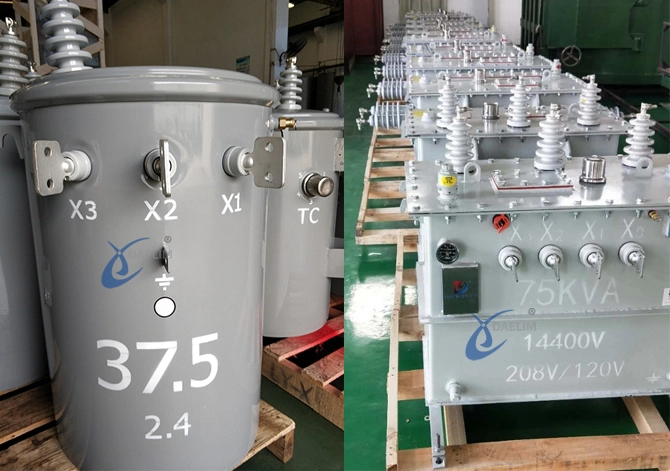
To put it simply, three-phase power (in kW or kVA) is only three times the single-phase counterpart.
Knowing the voltage and the VA allows for a straightforward calculation of the current.
To calculate current, you'll need to use the phase voltage, which is the square root of the line voltage.
In most cases, a single-phase UPS is all that's needed to power rack-mounted servers, phones, computers, network switches, and other devices that just require a standard three-pin connection.
With only one more wire, a three-phase MVA transformer rating can carry three times as much energy as standard, single-phase KVs.
Daelim Is Your Dependable Transformer Rating Guide
If you're looking for a transformer manufacturer that can guide you with all the power transformer ratings with a transformer rating chart, you've come to the right place.
At Daelim, we know that you want to make sure that your transformer is electrically high quality—and that it's going to last.
That's why we've created this comprehensive list of ratings and specifications for all of our transformers, so you can be sure they're built to last and meet your needs.
We've also got an easy-to-follow transformer rating chart that will help you determine just what kind of transformer it is and give you a good idea of what kind of power it can carry.
Whether you're looking for an industrial transformer or a small, portable model, Daelim always has the right one for your needs.
Related Products
Related Article
The Ultimate Guide To 100 kVA Transformer
Daelim’s transformers with Ul/Cul, CSA, CESI, ISO and other certificates. The design and production standards are completely consistent and exceeded ANSI/IEEE, CSA, DOE, IEC, AS, GOST, EN, etc. Exit thousands of 100 kVA transformers each year to North America, South America, Europe and other regions.And according to customers’ needs, Daelim give the most cost-efficient solutions.
The Ultimate Guide To 30 MVA Transformer
The transformer of 30MVA capacity is usually a high-voltage grid level.s a professional transformer supplier, Daelim can provide transformer voltage levels with 35 kV, 38 kV, 66 kV, 69 kV, 110 kV, 115 kV, 132 kV, 138 kV, 220 kV, 230 kV, etc
Basic knowledge about the use of transformers
This paper mainly introduces the use of transformers, including step-up transformers, voltage drop transformers, auto transformers, single-phase transformers, and three-phase transformer. Secondly, it briefly describes the causes of transformer fire and explosion.





